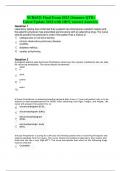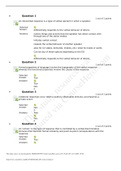Summary
Full summary - Behavior and the Brain part 2: Cognitive Neuroscience (P_BBAC_2)
- Course
- Institution
This document comprehensively covers the content from the second part of the Brain and Behavior Pre-minor, focused on cognitive neuroscience. It provides a thorough understanding of essential concepts, ensuring comprehensive preparation for understanding the intricate workings of the brain. Hope th...
[Show more]












